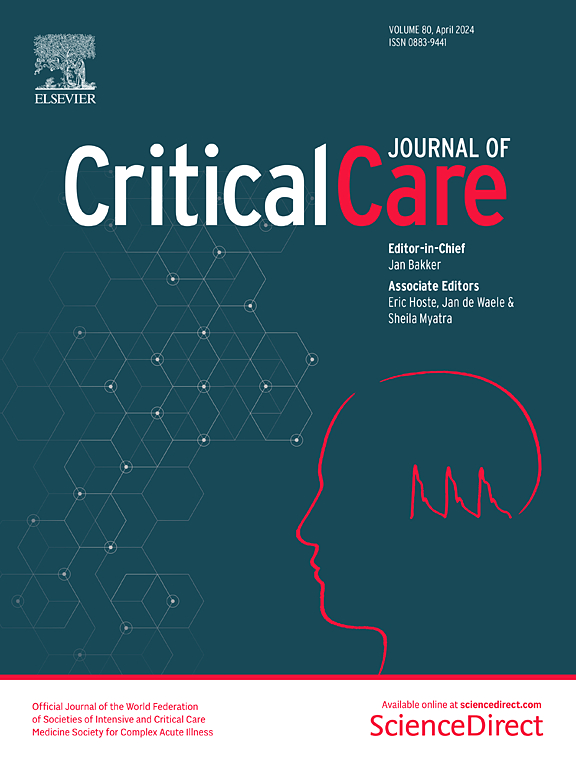使用NSE水平和动力学、脑电图和SSEP对心脏骤停后昏迷患者有利的神经预后进行多模式评估
IF 8.8
1区 医学
Q1 CRITICAL CARE MEDICINE
引用次数: 0
摘要
心脏骤停(CA)后良好神经预后的预后指标仍然有限。我们的目的是评估神经元特异性烯醇化酶(NSE)、脑电图(EEG)和体感诱发电位(SSEP)在预测良好预后方面的预后价值,分别评估和联合评估。回顾性研究在三级CA中心进行,采用前瞻性登记。我们纳入了所有停止镇静后昏迷的患者,并在CA后24、48或/和72小时进行了一次脑电图和NSE血液测量。主要结果是3个月时良好的神经学结果,脑功能分类(CPC)量表1-2定义了良好的结果。2017年1月至2024年4月期间,纳入215名患者。参与者年龄63岁(IQR[52-73]), 73%为男性。3个月时,54例(25.1%)患者预后良好。与不良结局组相比,良好结局组24小时NSE血水平显著降低(39 IQR[27-45] vs 54 IQR[37-82]µg/L, p 0.85µV预测良好结局(PPV 75%, Se 100%)。48 h时NSE < 51.5µg/l, 24 ~ 72 h间NSE呈下降趋势,脑电图呈良性时,预测效果最佳(PPV 96%, Se 76%)。在CA后的昏迷患者中,低NSE水平在24、48或72小时,随着时间的推移,NSE呈下降趋势,良性脑电图和高N20振幅是有利结果的有力标志,减少了预后的不确定性。本文章由计算机程序翻译,如有差异,请以英文原文为准。
Multimodal assessment of favorable neurological outcome using NSE levels and kinetics, EEG and SSEP in comatose patients after cardiac arrest
Prognostic markers of good neurological outcome after cardiac arrest (CA) remain limited. We aimed to evaluate the prognostic value of neuron-specific enolase (NSE), electroencephalogram (EEG) and somatosensory evoked potentials (SSEP) in predicting good outcome, assessed separately and in combination. A retrospective study was conducted in a tertiary CA center, using a prospective registry. We included all patients comatose after discontinuation of sedation and with one EEG and NSE blood measurement at 24, 48 or/and 72 h after CA. The primary outcome was favorable neurological outcome at three months, a Cerebral Performance Categories (CPC) scale 1–2 defining a good outcome. Between January 2017 and April 2024, 215 patients were included. Participants were 63 years old (IQR [52–73]), and 73% were male. At 3 months, 54 patients (25.1%) had a good outcome. Compared to the poor outcome group, NSE blood levels were significantly lower in the good outcome group at 24 h (39 IQR[27–45] vs 54 IQR[37–82]µg/L, p < 0.001), 48 h (26 [18–43] vs 107 [54–227]µg/L, p < 0.001) and 72 h (20 µg/L IQR [15–30] vs 184 µg/l IQR [60–300], p < 0,001). Normal NSE (i.e., < 17 µg/L) at 24 h was highly predictive of good outcome, with a predictive positive value (PPV) of 71% despite a sensitivity (Se) of 9%. The best cut-off values for NSE at 24, 48 and 72 h were below 45.5, 51.5 and 41.5 µg/L, yielding PPV of 64%, 80% and 83% and sensitivities of 74%, 93% and 90%, respectively. A decreasing trend in NSE levels between 24 and 72 h was also highly predictive of good outcome (PPV 82%, Se 81%). A benign EEG pattern was more frequently observed in the good outcome group (87.1 vs 14.9%, p < 0.001) and predicted a good outcome with a PPV of 72% and a Se of 94%. Regarding SSEPs, a bilateral N20-baseline amplitude > 0.85 µV was predictive of good outcome (PPV 75%, Se 100%). The combination of NSE < 51.5 µg/l at 48 h, a decreasing NSE trend between 24 and 72 h and a benign EEG showed the best predictive value (PPV 96%, Se 76%). In comatose patients after CA, a low NSE levels at 24, 48 h or 72 h, a decreasing trend in NSE over time, a benign EEG and a high N20 amplitude are robust markers of favorable outcome, reducing prognosis uncertainty.
求助全文
通过发布文献求助,成功后即可免费获取论文全文。
去求助
来源期刊

Critical Care
医学-危重病医学
CiteScore
20.60
自引率
3.30%
发文量
348
审稿时长
1.5 months
期刊介绍:
Critical Care is an esteemed international medical journal that undergoes a rigorous peer-review process to maintain its high quality standards. Its primary objective is to enhance the healthcare services offered to critically ill patients. To achieve this, the journal focuses on gathering, exchanging, disseminating, and endorsing evidence-based information that is highly relevant to intensivists. By doing so, Critical Care seeks to provide a thorough and inclusive examination of the intensive care field.
 求助内容:
求助内容: 应助结果提醒方式:
应助结果提醒方式:


